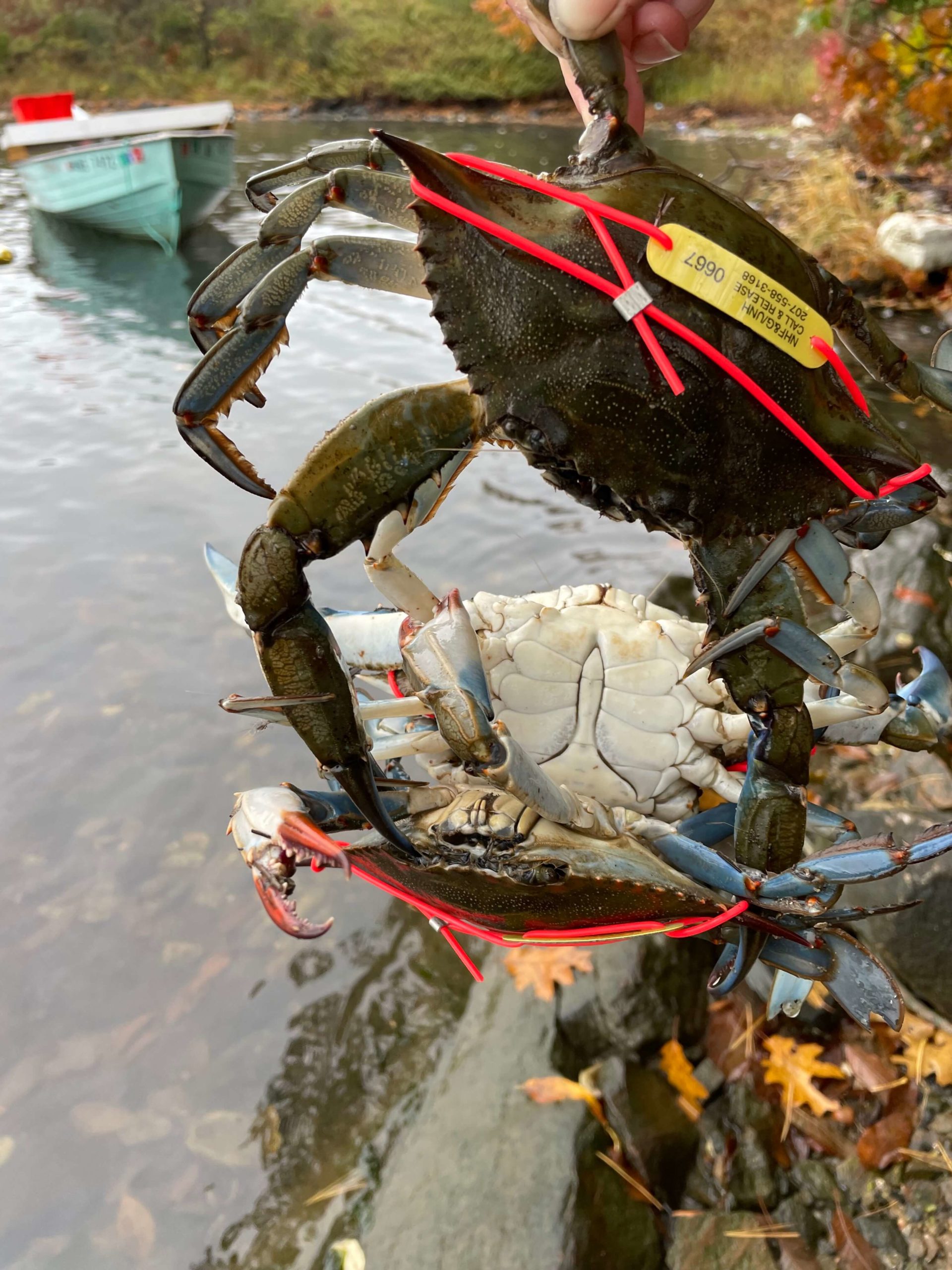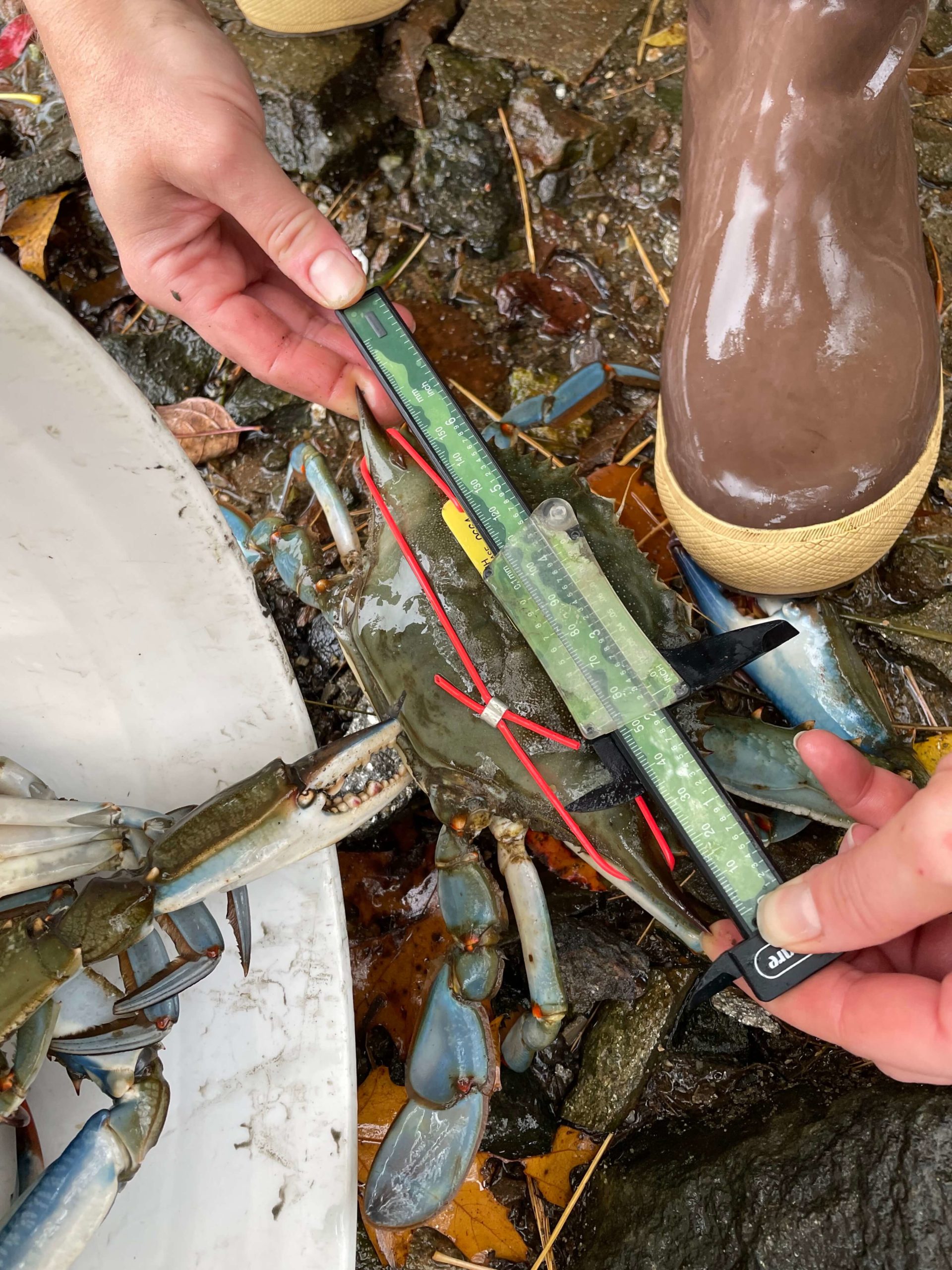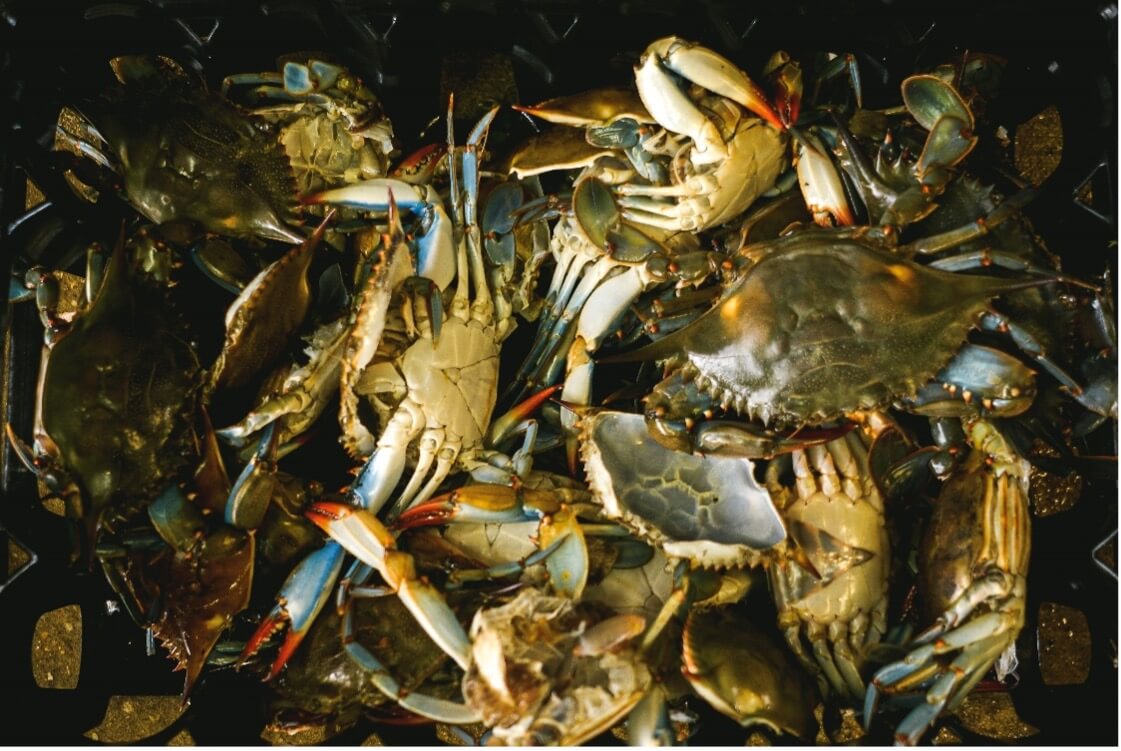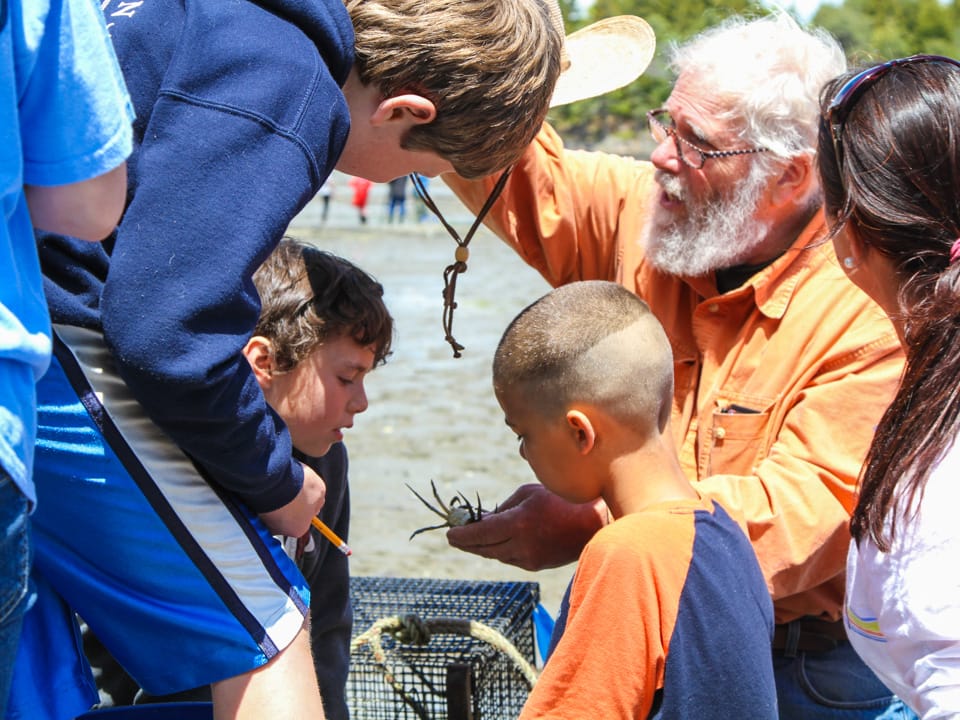The Gulf of Maine’s warming waters are making conditions just right for this historically mid-Atlantic resident to set up shop. How will their emergence affect Maine’s fishing industry, and what are community members doing to help scientists measure their impact?
By Rafeed Hussain
Beautiful. Savory. Swimmer. That’s what the scientific name for Atlantic blue crabs aptly translates to. These delectable decapods are quintessential to the fabric of the mid-Atlantic seafood scene, culture, and economy. In fact, about half of all blue crabs sold in the U.S. come from Chesapeake Bay.
But climate change may be redefining what’s considered home territory for blue crabs—and for the North Atlantic fishing communities whose livelihoods depend on the Gulf of Maine ecosystem.
“Historically, outside of the occasional sighting, blue crabs were rarely found north of Cape Cod. That’s started to change in recent years, as waters have warmed,” explains Dr. Marissa McMahan, Manomet’s director of fisheries. “Seeing blue crabs in the Gulf of Maine suggests that they are another climate migrating species that is shifting their range northward with warming waters.”
In the summer of 2021, Maine fishermen and harvesters shared with researchers at Manomet their observations about the growing prevalence of blue crabs in their traps. At the same time, researchers at Northeastern University and the University of New Hampshire also started finding blue crabs in their traps in southern Maine while monitoring for invasive and other climate-driven range-expanding species like green crabs and black seabass, respectively. Moreover, scientists at the Wells and Great Bay National Estuarine Research Reserves began seeing blue crabs in their traps more regularly as well, differing from past disparate and sporadic sightings.
Most surprisingly, a University of New Hampshire graduate student researcher observed a pair of mating blue crabs in Great Bay Estuary—the first ever reported in the area. This suggests that the conditions are ripe for blue crab population growth.
“This is not a one-off [occurrence]. They’re coming—and they could be here to stay,” says Dr. Gabriela Bradt, fisheries and aquaculture specialist at New Hampshire Sea Grant and the University of New Hampshire Cooperative Extension.
This string of uncommon sightings prompted all four institutions to pool their resources and work together to study and understand the impacts of the potentially burgeoning population. With the help of community science data—data collected and shared by members of the public—Manomet and partners are establishing a baseline dataset.
“[In order to understand] a species that is rapidly expanding its range, you start broad [by monitoring] distribution and abundance,” says Dr. McMahan. “Where are they? How many are there? That’s the first thing you try to tackle.” Answering these questions can inform what potential ecosystem impacts there may be, how that might impact the local economy, and strategies that could help drive sustainable management of the species in the future. Researchers are confident that climate change induced ocean warming is one of the major drivers contributing to what’s causing the blue crab to expand its range.
Climate Change in the Gulf of Maine
The Gulf of Maine is warming faster than almost any other body of water on Earth. It grew 3.2 degrees Fahrenheit warmer over the last four decades—about three times higher than the rest of the world. In addition, three of the four warmest summers ever recorded in Gulf of Maine waters occurred in 2020, 2021, and 2022. These high temperatures, once anomalies, are slowly becoming the new normal.
Like many species, the blue crab’s lifecycle and habitat are temperature dependent. The warming waters of the Gulf of Maine are more hospitable for the species than in years past, enabling their northward expansion.
“Environments that were previously inhospitable are becoming lovely places to set up shop,” says Bradt. Though blue crabs have been seen along the western Atlantic coast from Nova Scotia to Argentina and the Gulf of Mexico, until recently, it was uncommon to find them north of Cape Cod. They are so unusual that there are currently no regulations regarding harvesting blue crabs in Maine and New Hampshire. With the blue crabs’ potential range expansion and resulting ecosystem impacts, that may soon change as well.

Environmental and Socioeconomic Impacts
One reason researchers are paying close attention to the growing frequency of blue crab sightings in northern New England is the potential cascading ecosystem impacts a population may have in the Gulf of Maine, especially in intertidal habitats where Maine shellfish harvesters and fishers make their living.
Blue crabs are voracious predators and scavengers, eating almost anything they can get their claws on, including oysters, clams, mussels, other crabs, and even juvenile American lobsters, an iconic fishery in the Gulf of Maine. Lobsters, especially young lobsters, are found in estuarine habitats. Since blue crabs and lobsters typically inhabit these similar spaces and depend on the same food sources, there are concerns that blue crabs will affect Maine’s lobster populations and fishery as well as other economically, environmentally, and culturally important species.
“As blue crabs become the new kids on the block in the Gulf of Maine, we want to know how they and other range-expanding species will impact native residents like the American lobster, their life history, and their recruitment into the population and into the fishery” says Helen Cheng, Ph.D. candidate at Northeastern University and NOAA Margaret A. Davidson Fellow at Wells National Estuarine Research Reserve. “This will provide a snapshot of what the changing Gulf of Maine ecosystem will look like.”
“Blue crabs are a potential new predator of shellfish and are likely using intertidal habitat at high tide,” says McMahan. “We can start to understand seasonal movement and habitat use from our observation data, and if we pair this with additional information from stakeholders, we can start to understand what species blue crabs are interacting with and subsequent socioeconomic [and ecological] impacts.”
In a place like Maine, where seafood is so central to the state’s identity, maintaining a healthy marine ecosystem is paramount. In 2021, lobsters comprised 82 percent of Maine’s nearly $900 million commercial catch. Soft-shell clams made up 3 percent of total landings, and scallops and oyster species made up 1 percent each. And they are all on the blue crab’s menu.
But researchers are finding ways to turn lemons into lemonade—or crabs into crabcakes—by creating a new commercial blue crab fishery in Maine. As McMahan says, “If you can’t beat ‘em, eat ‘em!”
Unlike species like the green crab, “blue crabs are great because they market themselves,” says Jessie Batchelder, fisheries project manager at Manomet. “[They’re already] a delicacy in a lot of places along the Atlantic coast.” A blue crab fishery could hypothetically offset some of the species’ potentially detrimental financial impacts, but it’s too early to tell.
Even if blue crabs become commercially viable, there would be questions to answer on how to best manage the species or if people would even consider changing fisheries. Those are some of the other questions researchers are hoping to be able to help address and inform through their monitoring work. “Our goal is to inform the people in charge of making policy and give them the best, up-to-date data that they can then hopefully formulate into policy that is agreeable for everyone,” says Bradt.

The Vital Role of Community Science
The inter-institutional research team relies on a trapping methodology developed by the Wells National Estuarine Reserves with crab traps placed in several New Hampshire and Maine locations. Despite focus from four institutions, there still are not enough resources to effectively collect the necessary data from across the Gulf of Maine.
“Because these changes are happening so rapidly, we don’t have the tools in our toolbox as scientists and fisheries managers to monitor and react in real time,” says McMahan. “It’s been challenging trying to get a grasp on what’s happening.” As a result, the groups joined the first-ever Gulf of Maine Blue Crab Network, created by the Wells National Estuarine Research Reserve, to help foster collaboration among all relevant organizations associated with Gulf of Maine fisheries to get the most detailed picture possible of potential blue crab proliferation.
The collaborative developed a crowd-sourcing website that enables anyone to enter information about blue crab sightings. We now have data collected and shared by members of the public who aren’t necessarily researchers. In this case, they are community members who have acquired a treasure trove of relevant knowledge by working on the ocean and coasts to make a living. Each institution reached out to its stakeholders who work out on the water to be the eyes and ears for everyone who depends on the Gulf of Maine’s vast resources to put food on the table. Without them, none of this work would be possible.
“Fishermen are on the water every single day,” says McMahan. “They’re on the front lines of climate change and observing these changes, and they possess knowledge that is unparalleled in terms of just the scale at which they are seeing this happen. Certainly, [at] finer scale[s] than we can ever hope to replicate with a scientific study because we’re never going to be able to be on the water every single day.”
Scientists are the most impactful, and their conclusions are the most accurate when they collaborate with the communities they’re surrounded by, incorporating all their hard-earned knowledge in the data collection process. “We’re not out there just telling everyone how things should be,” says Batchelder. “It takes everyone, and it takes a community. And that’s how the most impactful changes happen.”
Have you seen a blue crab in the Gulf of Maine? To report a sighting, or view locations where blue crabs have been found, visit manomet.org/fisheries.





 Back to all
Back to all
